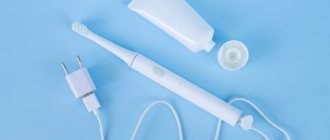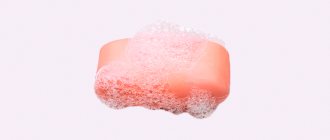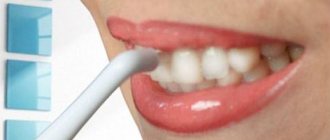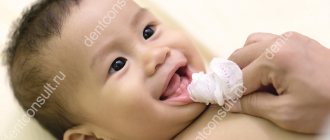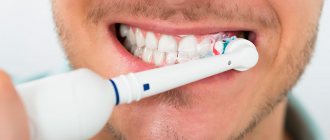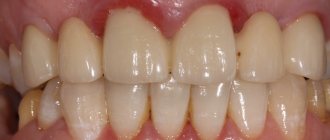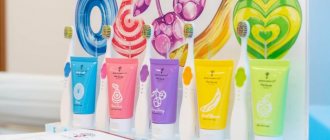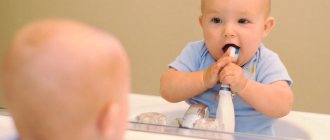Any toothbrush has a limited lifespan. Over time, the bristles wear out and fall out, microbes accumulate on them, and it becomes useless and even dangerous for the teeth. There is a risk of developing caries, periodontal disease and other diseases. To prevent this from happening, you need to periodically change the brush. Let's find out how often to do this and why.
In this article
- Why you need to change your toothbrush
- How often should you change your brush?
- How often should you change your electric toothbrush?
- How to determine that your toothbrush needs to be changed
- What happens if you don't change the brush?
Complete oral hygiene includes not only the daily use of brushes, pastes, rinses and balms, but also regular replacement of hygiene products. Otherwise, they can turn into a risk factor and lead to the development of dental diseases. We'll tell you why you need to change your brush regularly and when to do it.
Why you need to change your toothbrush
A brush used regularly, over time, not only loses its appearance and the original elasticity of the bristles, but also becomes an accumulator of a large number of harmful bacteria transferred from the surface of the teeth and gums. With short-term use, the density of bacterial accumulation is not too high and cannot cause harm. After some time, bacteria accumulate and can “relocate” back to the surface being cleaned, creating the risk of developing many negative consequences. Bristles that have lost their elasticity not only contribute to this transfer, but can also become a traumatic factor for the gums, further aggravating the current situation.
the most acceptable period for changing a toothbrush to be 3 months.
If necessary, a replacement can be made earlier than the specified time, but it is highly undesirable to postpone the purchase of hygiene products for a longer period.
Colored indicators on toothbrushes
Colored bristles on toothbrushes nowadays are not only decorative, as many thought, but also make our lives easier. By their brightness you can also determine the suitability of a toothbrush. The paler they are, the closer the toothbrush is to the end of its life in your bathroom. According to statistics, their fading time is still the same three months.
How often should adults and children change their toothbrush?
For proper cleaning, many dentists recommend changing your toothbrush every 1-3 months. Natural bristles are the least resistant to wear and tear. Elastic fibers quickly break off and become frayed, becoming unsuitable for proper cleaning.
How often should an adult change their toothbrush?
In connection with the above information, adults need to change toothbrushes once every 1-2 months.
Thus, answering the question: how many times should you change your toothbrush , you can answer: 4-6 times a year. It is worth considering that the indicated amount may vary depending on the factors listed above.
How often should children change their toothbrush?
A child's first toothbrush is a silicone massager that fits on the finger. The use of this device is advisable during the period of eruption of the first teeth and provides not only their cleaning, but also massage of the gingival surface. After each use, the massager must be disinfected in a special solution, or by boiling. In this regard, we are not talking about the accumulation of pathogenic bacteria in this case. However, gum massagers need to be replaced every 3-4 months.
When a child reaches the age of 1 year, it becomes necessary to use a full-fledged toothbrush. The choice most often leans towards bristles made from synthetic materials, which are least susceptible to contamination by microorganisms, have high elasticity and are easier to process. Starting from the age of 2, brushing teeth with brushes that have both synthetic and natural bristles is acceptable. A child's toothbrush is replaced at the same frequency as for adult family members; therefore, children of this age should change their toothbrush once every 2-3 months.
When can you start using electric models?
Experts in pediatric dentistry do not recommend purchasing electric toothbrushes for children under 2 years of age. In general, experts advise starting to use them no earlier than 5 years. In any case, it is impossible to use an electric model on an ongoing basis at an early age. The enamel of baby teeth is quite thin and fragile and can be easily damaged. Starting from 5-6 years old, you can begin to periodically use an electric model - the teeth should gradually get used to its effects.
An electric brush can be used from 5-6 years old
How often should you change your electric toothbrush?
The electric toothbrush itself is designed for a long service life, estimated at several years and depending primarily on the performance of the motor performing the work. Cleaning attachments must be replaced regularly. It is recommended to change them in the same way as a regular brush, i.e. every 2-3 months, unless circumstances arise that require a reduction in the specified period (damage to the bristles, previous diseases, mold damage, etc.). This is due to the fact that the bristles for the attachments are made from the same materials as regular toothbrushes. Read more about the benefits and harms of electric toothbrushes here.
Nuances for an electric brush
The most effective way to clean your teeth from food debris and plaque is with an electric toothbrush. It comes with a variety of replacement cleaning attachments. If there are not enough attachments, they can be purchased separately.
With use, the bristles on electric brushes also wear out, as evidenced by a tarnished indicator. This happens after about three months of using the device. In this case, you should immediately replace the cleaning head with a new one.
If the electric brush is not equipped with an indicator, you still need to change the brush head after three months of using the device . This will help keep the oral cavity clean and prevent the development of inflammatory processes.
How to tell when your toothbrush needs to be replaced
The maximum period of use of even the best brush is 3-4 months. Even if it seems cleanable and looks good, it is still worth replacing. The main reasons for replacing your toothbrush are listed below:
- The service life of the brush exceeded 3 months;
- After suffering infectious diseases, to avoid re-infection;
- Wear of the bristles, their fraying, change in original color;
- Accumulation of plaque, visually noticeable on the surface;
- Use of a brush by another person;
- The appearance of signs of black mold infestation;
When replacement is required earlier than standard
Sometimes the brush may need to be thrown away after a few days of use, or much sooner than three months. There can be many reasons for this:
- Past infectious diseases. These include, but are not limited to, ARVI, influenza and herpes. Even after treatment, using a brush will be dangerous because the risk of re-infection is very high. It's easier to change the item and not take risks.
- Heavy wear. How do you know if wear is bad? Pay attention to the stubble. From the outside it will appear shaggy, the fibers will become frayed and begin to stick out in all directions. Using such a brush is dangerous for your gums.
- The bristles have changed color. This can happen for various reasons - from a reaction to toothpaste to poor quality of the material. Signs may include yellowing, darkening, or spots.
- Heavy pollution. Some models are designed in such a way that during their use, a large amount of plaque begins to accumulate at the base of the bristles. This place is a real breeding ground for germs; you should get rid of the brush and not buy a similar model again.
- A fall. Even if you regularly wash the floor or have treated the item, it is worth replacing it. The reason is that microbes may still remain on the surface, which then enter your body and can provoke a variety of diseases.
- Use by another person. This is true even if it is a member of your family and if he does not suffer from any oral diseases.
In some rooms, conditions are such that mold spreads very quickly. Brushes with deposits should not be used.
What happens if you don't replace your toothbrush on time?
A toothbrush used for more than several months, after a certain time, not only loses its aesthetic appeal, but can also become an object that can cause at least discomfort during use. In the worst case scenario, a toothbrush not replaced in a timely manner can cause many problems, such as:
- Injury to the gums and bleeding;
- Infection of soft tissues of the oral cavity;
- Development of gingivitis, periodontal disease and caries;
- Increased level of plaque accumulation;
- Unpleasant odor;
- Possibility of re-infection after illness;
- The risk of contracting a number of diseases if another person used the toothbrush.
In order for the toothbrush to fully and safely perform its functions during the permissible period of use, it is necessary to adhere to the rules of care and storage.
What are the consequences of untimely replacement?
Although it's tempting to extend the life of your toothbrush, you shouldn't do it. Using it too long will lead to serious problems:
- discomfort/pain during cleaning;
- microtraumas of the oral cavity;
- bleeding gums;
- infection of soft tissues;
- inflammation of gum tissue;
- development of gingivitis, caries, periodontal disease and other diseases;
- development of systemic infections;
- formation of dental plaque, stone;
- the appearance of bad breath.
If your teeth are not properly cleaned, you will have to visit the dentist more often, and this is a much greater inconvenience than replacing your brush every quarter.
If it is difficult for you to keep track of the timing, it makes sense to purchase a brush with an indicator - at the end of its service life, the bristles will change color and indicate that it is time to replace it. And even if you conscientiously change hygiene products strictly at the allotted time, you should not forget about caring for them, this is the only way to protect yourself from dental diseases and enjoy life without pain.
Rules for the care and storage of a toothbrush
- After each use, the toothbrush is thoroughly rinsed under running water. For better processing, you can rinse the brush in boiling water. However, prolonged contact with high temperatures can cause damage to the bristles;
- At least once a week, the brush must be treated with a disinfectant solution. An affordable and high-quality disinfectant is ordinary hydrogen peroxide;
- The toothbrush is stored in a container that has holes to drain any remaining water on the bristles. Otherwise, black mold, which is extremely dangerous to health, may form, both on the glass and on the toothbrush itself. The ideal option would be to dry the bristles and use special cases that have the ability to emit ultraviolet light;
- It is recommended to store the toothbrush covered in a special cap that protects the bristles from external influences.
Separately, you should pay attention to the hygiene products that were used during the trip or hospital stay. Such toothbrushes must be replaced with new ones immediately after returning home. This is due to the fact that under these conditions, the risk of bristle infection by various pathogens increases significantly.
In addition to proper storage of the brush, accuracy in its choice plays a big role.
How to store?
To store this important item, you should adhere to the following rules:
- Use an individual cup or a special holder. Under no circumstances should you place the brushes of all family members in one container. This way they will come into contact with the bristles, and pathogenic microbes from one brush will end up on the other. When brushing teeth, a healthy person will become infected from a sick person.
- It is not advisable to store a toothbrush in a cabinet located in the bathroom. Lack of light, humidity, elevated temperatures and poor air circulation contribute to the appearance of mold.
- Please note that in a shared bathroom, the brush should not be located next to the toilet . When washed off, it will get splashed with germs, which is not at all hygienic and can lead to the development of various diseases.
- In the container or holder, the toothbrush should be in an upright position, with the bristles facing up . This way the water will drain faster and pathogenic microbes will not have time to multiply.
- Of course, the holder or glass must be clean . If they become dirty, wash them with warm water and soap.
- You cannot put the cap on a wet brush. It is necessary to dry the bristles well first.
- It is recommended to use cases only when traveling. They do not allow air to pass through, so there is a risk of pathogenic microflora appearing.
Attention! The brush that will be placed in the case must be dry.
A toothbrush is a faithful assistant in keeping teeth and gums healthy. It is only necessary to change it once every three months so that accumulated microbes and damaged bristles do not lead to the development of caries, periodontal disease, stomatitis or gingivitis. It is also important to properly care for your brush and follow the rules for storing it.
How to choose the right toothbrush
Bristle hardness
Manufacturers offer bristles of 3 types of hardness:
- Soft. Suitable for children and people suffering from gum disease that causes bleeding and pain;
- Medium hardness. It is a classic option, most popular among consumers. This is explained by the optimal balance between a delicate attitude during processing and good cleaning quality. Such bristles are suitable for both natural teeth and most types of dentures;
- Tough. High-stiffness bristles should only be used on the recommendation of a doctor. As a rule, an indication for the use of such brushes may be excessively increased formation of dental plaque.
Location and shape of bristles
Angled, beveled bristles remove plaque more effectively and allow you to thoroughly clean your molars. Multi-level trimming of the bristles allows you to clean the side surfaces of the teeth and penetrate even into narrow spaces. The presence of oblique beams increases the coverage area and extends, including to the area of the tooth neck.
